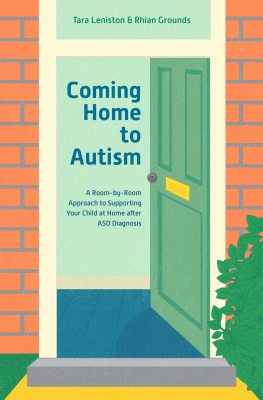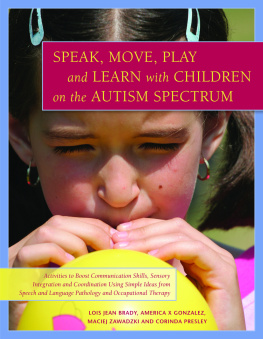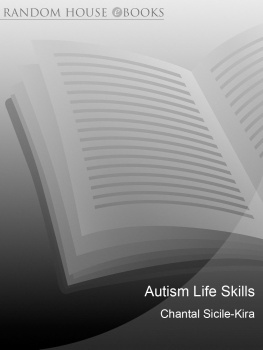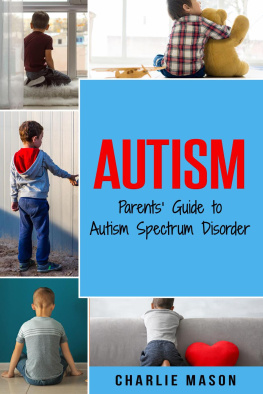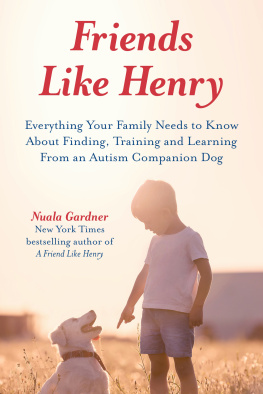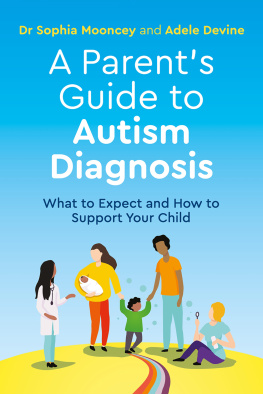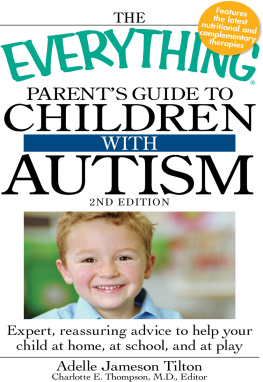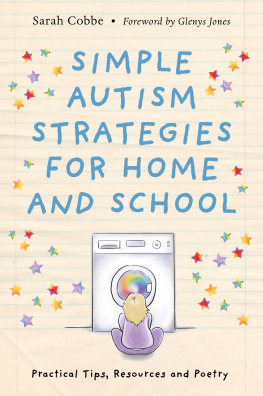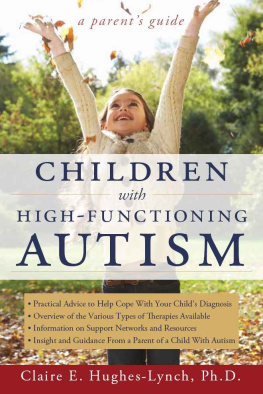
Coming Home
to Autism
A Room-by-Room Approach to Supporting
Your Child at Home after ASD Diagnosis
Tara Leniston
and Rhian Grounds

Jessica Kingsley Publishers
London and Philadelphia
CONTENTS
INTRODUCTION
Tara the mum
Christmas 2011 was the first time I started to notice that Dylan was withdrawing from everyone, including me. His eye contact started to wane and he was no longer responding to his name.
The whole family was visiting and whereas before Dylan had been a smiling babbling baby, loving all the attention my family lavished on him, he now started to scream when anyone touched him and preferred to hide under the table, playing with his cars. At night, he would bounce for hours in his cot, flapping his hands and making sounds.
I first took him to the doctor a few weeks before his second birthday. I was told I was worrying over nothing and that he was a perfectly normal boy and all children developed differently. I went away still knowing something wasnt quite right. I kept a diary of all his traits and started to observe other children in the playground.
As a first-time mother, I wasnt sure what was normal and what wasnt. But it was clear from looking at the other children that Dylan was quite different. I returned to the doctor adamant that he must be going deaf, as he was no longer responding to me at all. The doctor begrudgingly referred me on to the ENT (ear, nose and throat) department. Dylan passed the assessment with flying colours. After the assessment, I was met by a lovely paediatrician who had been observing our session and I was asked to come back a week later for a series of tests and for them to observe Dylan. Over the next few weeks and months Dylan was observed and I was then given the news that he was on the autistic spectrum.
I asked if there was anything I could do; they politely told me No, I am afraid not. They told me there was no cure and they had no idea of what the future would hold for him.
I walked out of there feeling like all the breath in my lungs had gone. I was scared and distraught, my mind flashing to scenes of the film Rain Man . Was this what my boy was going to be like? When I got home and put Dylan to bed, I sobbed and sobbed. My heart ached and I wanted it all to be just a bad dream.
The next morning, I woke up with a fire in my belly and my head racing with thoughts. I wanted to know everything there was to know about autism. What would help? What therapies should he do? How would I get support?
One of the first conversations I had was with my sister who offered me much-needed support and cried with me. Her husband was studying diet and nutrition at the time, and suggested I take Dylan off dairy, wheat and gluten. He told me the effects this has on most peoples bodies and that it might help Dylan; with this information I started researching some more. I promptly took Dylan off wheat, gluten and dairy, which was difficult as he had many food adversities and his main food staples were bread and milk. I found gluten-free options and switched Dylan from cows milk to goats milk. Within two weeks, Dylans eye contact started to improve and he started responding to his name. I couldnt believe that such a small change could have such a huge effect. Maybe I could not cure autism but I could sure do as much as possible to give Dylan the best possible chance at living a fulfilling and healthy life.
The brain is at its most adaptable from the birth until the age of eight, so I had a few years to do as much as I could to give Dylan the best chance of not only being able to integrate into society but also to enjoy it.
Over the next few weeks a friend put me in touch with her friend who did play therapy with autistic children. She came and did a few sessions with him and referred me to some books to read, giving me games that I could play with Dylan to connect with him. If he didnt want to be in my world, I would go into his.
I found a local play group for children with special needs and began going twice a week. I went on courses and read many medical books on autism and the gut. I got Dylan into a specialist school setting which he attended three days a week. It was intense as it pushed Dylan out of his comfort zone, but offered him a routine in which he thrived. Luckily, with the support of my partner, I was able to stay at home and research and go on these courses that would arm me with the knowledge that I needed to help my child.
I wanted to write this book because I wanted to help parents like me. Hearing the news that your child has autistic spectrum disorder (ASD) may be one of the worst things you will ever hear. The loss of control, the unknown, the what-ifs. There were books I read about ASD with diaries from other parents which offered some comfort but at the same time filled me with fear. There were also conspiracy theory books on why my child had ASD, and books with so much medical information or so full of words I couldnt understand that it sometimes took me months if not a year to get through them.
At the end of the day, I wanted to write a practical book, a book that gives you back some control, some hope that it will be OK. This is your child. Children on the spectrum are not sick; they do not have a disease. They simply think in a different way from you or me. I am not saying its easy but I hope that my book will offer some practical advice and support on how to make living at home with ASD easier. I am not a doctor nor an ASD specialist. I am simply a mother with a passion to help my son find his way in this world. To love and be loved. I will never be able to cure Dylan of his ASD, and to be honest I am not sure I would want to, as many of his traits that I love are part of his ASD.
I wanted to include some photos of Dylan, my family, friends and our home. All of the photographs are available to download in full colour from www.jkp.com/catalogue/book/9781785924361.
Rhian the speech and language therapist
My interest in autistic spectrum disorder (ASD) started when I was very young. I was in secondary school wondering what job would be fulfilling and interesting. I wanted to make a difference. I saw an advert seeking volunteers to support a local family in teaching their young autistic son. I worked with the family for a few years and researched jobs working with ASD. I witnessed the family struggle to understand their child and their never waning desire to support him to communicate his needs and emotions. This led me to speech and language therapy as my career. I started university thinking I would find the one therapy approach that worked for all. I even considered that by the time I graduated there would be conclusive answers to why ASD happened and possible cures developed.
I graduated and began working with children with all kinds of communication delays and disorders, always finding opportunities to work with those with ASD. First a job in clinics, then home-visiting therapy services, next mainstream schools, followed by specialist nurseries for children with a diagnosis or potential diagnosis. I began to get involved in the diagnostic process and became part of the observation and assessment team. I also began to educate parents, teaching staff and other professionals through training programmes. I moved on to discussing services with managers, striving to continually improve experiences for people with ASD and their families.
As I met more young people with ASD, I realised that each communication therapy programme needed to be bespoke and adapted, not only to their individual profile of skills and needs but also adapted through trial and error, based on their response to the therapy. I learned that there is no single approach for all. I also realised the joy of finding a way to communicate with each child and interpreting and shaping their communication. I truly believe that all our approaches should have the primary aim of uncovering joy and providing motivation in learning. I also believe that for this to happen in busy family life this needs to fit into daily life. I only work with children from 9am to 5pm but even in that time I find that approaches need to be embedded in daily routines to be sustainable and effective.
Next page
